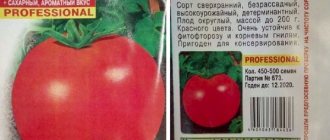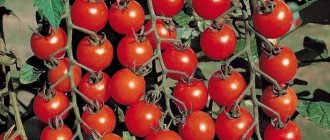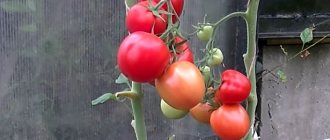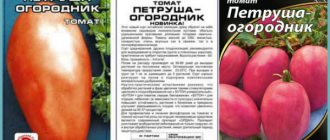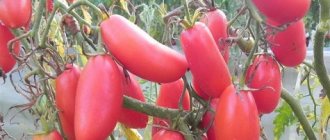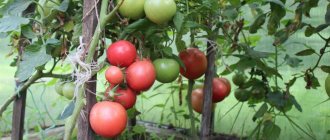Description and characteristics of the variety
The Cyfomandra tomato variety is named after a unique plant from South America called the “tomato tree.” It is suitable for cultivation in different regions of Russia in open ground, a greenhouse or under film cover, depending on climatic conditions.
- The plant is indeterminate and grows to a height of about 1-1.5 meters.
- A standard type bush, with a strong trunk and moderate branching.
- It is recommended to grow in 1-2 stems.
- The leaves are unlike tomato leaves; they are large, elongated, and resemble an elongated heart.
- Late ripening period. Tomatoes will ripen 120-150 days after germination.
- Up to 6-8 tomatoes are formed on one brush, which are larger at the bottom and become smaller at the top.
- Productivity is high, up to 6 kg per bush. From 1 sq. m harvest about 20 kg of ripe tomatoes.
- Extended fruiting period; in closed ground, bushes can bear fruit for 7 months.
Protecting plants from diseases and pests
When grown in open ground, tomatoes are susceptible to attacks by slugs, and in a greenhouse - to attacks by whiteflies. In addition, the plant needs preventive treatment against late blight with preparations that contain copper or fungicides. To protect the plant from parasites and diseases, the following measures are taken:
- tomatoes are placed away from potatoes;
- Before planting seedlings, be sure to dig the soil deeply;
- plantings are periodically sprayed with Bordeaux mixture;
- soil and seed must be disinfected;
- watering should be moderate, preventing the appearance of rot;
- compliance with crop rotation;
- regularly remove weeds and plant debris;
- Before planting, Trichodermin should be added to each well.
Insecticides with enteric contact action help against whiteflies. And to get rid of slugs, freshly slaked lime is used, the soil near the tomato bushes is sprinkled with tobacco dust with the addition of lime and ash. Sprinkling the soil with ground black pepper is also effective against slugs.
Fruit characteristics
- Large-fruited.
- The average weight of one tomato is up to 200 g.
- The shape is round, slightly flattened, with slight ribbing in the area of the stalk.
- The color of ripe tomatoes is pink-raspberry.
- The pulp is dense, fleshy.
- Inside there are 6 or more seed chambers with an average number of seeds.
- The skin is dense but tender.
- Tomatoes do not crack.
- Sugar content is approximately 2.3%.
- The taste is sweetish, the aroma is delicate, unique to this variety.
- They have good keeping quality.
- Ripens perfectly outside the bush at room temperature, maintaining appearance and taste.
One hundred poods
The tomato variety 100 Poods from the manufacturer Sibirsky Sad has good reviews from plant growers. Gardeners value it for its tasty fruits of an original shape and for the friendly yield of the harvest. There are no zoning restrictions.
It has been grown since 2013; It is recommended to use summer greenhouses, but the variety has shown itself well in open areas.
The bush develops throughout the growing season. At a height of 1.8 m, the top of its head is cut off. The plant needs to be shaped and the shoots removed. In greenhouses, the bush is grown into one stem. In an open area, trellises are used and 2 stems are formed:
| № | Helpful information |
| 1 | Fruit ripening occurs after 110-114 days. The 100 Poods Siberian Garden tomato is large and has a pear-shaped shape. The surface is ribbed. Berry color red |
| 2 | the mass of a tomato with commercial characteristics is 250 g, but gardeners grow tomatoes of greater weight, up to 500 g |
| 3 | productivity of the variety Sto Pudov 9 kg/m2 |
| 4 | With timely feeding and regular watering, the tomato forms a strong bush, with a powerful stem and branches. The plant can resist infectious diseases |
| 5 | preventive measures are recommended against late blight, streaking, and Alternaria |
Tomato 100 Poods Siberian Garden is grown from seedlings aged 65-70 days. Sowing is carried out 85 days before planting in the ground. The seedlings are placed on the plot in increments of 50 cm.
Leave 60 cm between rows. Regular watering is necessary for plants. The Hundred Pudov variety loves moisture; after planting, the seedlings are immediately mulched with straw or sawdust.
Igor Nikolaev
auto RU
Tomato can tolerate temperature changes. Adult plants do not stop developing at a temperature of 18-20 C. Seedlings do not tolerate heat of more than 30 C. They must be protected from sunlight so that the leaves and fruits do not get burned.
More on the topic: How to care for a Bear Paw tomato?
Photo
The photo shows tomatoes of the Cypho Mandra variety.
Advantages and disadvantages
The main advantages of the variety include the following:
- Excellent taste.
- Long-term fruiting.
- They can be stored for a long time after collection.
- Easy to care for.
- High yield.
- Resistant to temperature changes.
- Good immunity against nightshade diseases.
There are not many disadvantages of the Tsifomandra variety, and even those listed below are insignificant.
- A garter to the support is required.
- It is necessary to apply fertilizing.
Reviews
Valentina
I heard about the tomato tree, but I didn’t pay attention to the Cyfomandra tomatoes. This year I decided to plant this crop on my plot. I thought that plants would be somewhat similar to trees. But in fact, these turned out to be ordinary tomatoes. Despite this, I really liked them. The fruits grow large and very juicy. They have a slightly sweet, very pleasant taste. On a 5-point system, I would give them an A. My tomatoes weighed 400-500 grams. The harvest was always good and very plentiful. The experiment worked. I really liked the variety. Now Cyphomandra is my favorite among other tomatoes.
Sergey
I came across this variety quite by accident. I saw a bag of seeds and decided to buy it. I planted the seedlings and then transplanted them into the greenhouse. I have never had such a harvest before. All the bushes were simply hung with tomatoes. They were very large, meaty and juicy. The fruits have simply excellent taste. The harvest was early, and we chose the fruits themselves for several months. So we had fresh salads on the table all summer. If tomatoes are picked green, they ripen well indoors. However, their taste does not change. Excellent variety. I couldn't be happier with them.
Features of cultivation
Seeds of the Tsifomandra tomato variety are produced by many originators, including the Siberian Garden .
Tomatoes can be grown in seedlings and also propagated by cuttings. Sowing of seedlings is carried out 60-65 days before planting in the ground. The seeds are first disinfected in a light solution of potassium permanganate, washed under water and dried.
The soil for planting should be light. It is better to make a mixture of equal amounts of garden soil and peat, to which a little washed river sand is added. The seeds are lightly buried in the soil, sprayed and left in a warm place for germination. To speed up this process, you can first keep the seeds in a growth stimulator, for example, Zircon.
When the first 2-3 true leaves are formed on the seedlings, they are picked into separate pots.
Advice! If the seeds are immediately sown in separate peat pots, picking will not be required.
The seedlings are transferred to open ground, a greenhouse or flowerpots after May 15, depending on field conditions. By this time, the seedlings will get stronger and up to 7 true leaves and the first flower clusters will form on them.
The soil for filling the holes is mixed with humus.
Seedlings are planted at intervals of 50 cm. Scheme: 3-4 plants per 1 sq.m.
If seedlings are transplanted into pots, drainage holes must be made in their bottom and placed on pallets.
Tall plants are tied to supports. The lateral stepsons are pinched, leaving a stump of 5-7 mm, so as not to damage the main stem. They can be used for rooting.
More information about growing tomatoes is described in the article: Technology of growing tomatoes. Secrets of planting and care
You might be interested in: How to properly plant tomatoes in a greenhouse: bush formation diagram, care features, photos and videos
Useful information: How to properly tie tomatoes in open ground: the best methods, step-by-step photo and video instructions
Care
Many summer residents are afraid to purchase new, and especially rare varieties of tomatoes, for fear of too complicated care. It’s such a shame if all your work is in vain, if you fail to harvest the harvest. However, the Tsifomandra variety does not belong to the category of difficult-to-cultivate tomatoes. Even though they are tall, they are no more difficult to care for than tomatoes, which grow much shorter. It is important to know and remember that the amount of harvest will depend on how the process of cultivating the land and bushes occurs. If agricultural practices are carried out correctly, the number of fruits can be doubled.
Basic rules of agricultural technology:
- Tomatoes love to drink, but they need to be watered properly. For the first time after transplantation, tomato bushes are watered only after 10-14 days. If you start watering immediately, the fragile roots will not have time to absorb moisture. The roots will simply begin to rot. In addition, further waterlogging of the soil will lead to a delay in the development of plants and delay the moment of fruiting. In addition, strong humidity is fraught with the occurrence of fungal diseases, which are very difficult to get rid of. Bushes need especially a lot of water during flowering and fruiting. Each bush should take up to 5 liters of warm, settled water daily.
- To ensure that water remains in the soil longer, the ground under the bushes is mulched. Straw, sawdust, and old grass act as mulch. Overheated mulch will decompose and thereby nourish the roots of the tomatoes. Mulch reliably protects the roots from overheating, less weeds grow under it, and the number of waterings can thereby be reduced.
- All tall tomatoes need to be shaped. It is better to keep the tsifomandra in one or two stems. It is advisable to leave 1 or 2 stepsons located under the first inflorescence. They will serve as stems - brushes will form on them, on which fruits will grow. Pruning must be done until the length of the sprouts exceeds five centimeters, otherwise the plant will be more difficult to survive removal.
Advice
: pruning of side shoots should be done in sunny, warm weather early in the morning, so that all wounds have time to dry out during the day. The removal procedure must be done manually without using a tool.
- It often happens that large double flowers appear at the top of plants; their appearance indicates that the plant development process is not going well. Perhaps the bush receives too much water or the external temperature changes too often. Such flowers should be removed immediately, as they produce ugly fruits. Such fruits require a lot of nutrition, which they will take from other ripening fruits.
- The lower leaves located at the very bottom of the stem are removed. They greatly shade the area under the bush, so moisture can accumulate there or pathogenic microflora can develop. All yellowed and tired leaves are also removed. Non-fruiting brushes are also removed. Only 2-3 leaves are removed at a time. The removal procedure should be carried out once a week.
It is important to focus not on the quantity of fruits, but on their quality. Therefore, during flowering, you can remove excess inflorescences. The remaining ones will grow into large and juicy fruits.
note
: the more flowers, the more fruits. But small in size.
It is important to build a reliable support immediately after planting the tomatoes. Cyphomandra bushes sometimes grow up to two meters high, and therefore require constant garters. It is best to use a trellis for this purpose and tie bushes to it every 30 centimeters of their growth.
- It is necessary to help the bushes to self-pollinate. To do this, you need to shake the branches and then sprinkle the air with water so that the pollen settles.
- Those fruits that managed to set before the beginning of August will have time to ripen in time, before the onset of night frosts. To help them ripen on time, you need to pinch the top of the plant 40 days before harvest, thereby stopping its growth. This will result in a redistribution of nutrition - it will be used to fill the fruit.
- For rapid growth of tops and fruits, plants constantly need additional nutrition. Tomato bushes need to be fed at least three times per season. The first fertilizers are applied two weeks after planting in the garden. Initially, plants need nitrogen, so nitrogen-containing substances are added to the soil along with organic fertilizers. When the second cluster of flowers blooms, it’s time for the second refill. For plants, a composition is prepared from complex fertilizer “Solution” or “Kimera universal”, copper sulfate and potassium permanganate. Up to two liters of nutrient mixture are consumed for each bush. The third feeding is carried out during intensive fruiting. Fertilizers will be needed to give the fruits juiciness and taste. The composition of the feed is the same as in the second feed.
Gardeners recommend irrigating the bushes with a solution of boric acid to enhance fruit growth and reduce flower falling. And to speed up the fruit set, add a little iodine to the water for irrigation. Cyphomandra bears fruit from August to October. In the last month, tired plants are released from their bindings and laid out on the ground. During this period, fruit ripening occurs. There is no need to water the bushes anymore. Since frosts may occur at the beginning of October, which can freeze the fruits, it is advisable to cover the bushes with a protective cloth at night.


